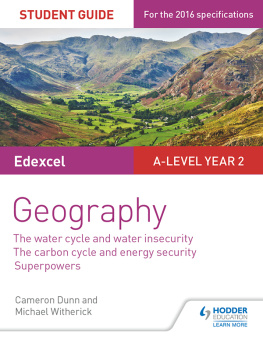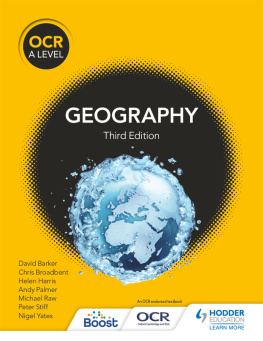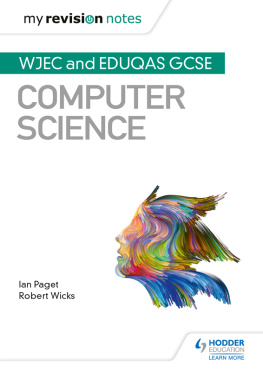Hodder Education, an Hachette UK company, Blenheim Court, George Street, Banbury, Oxfordshire OX16 5BH
Orders
Bookpoint Ltd, 130 Park Drive, Milton Park, Abingdon, Oxfordshire OX14 4SB
tel: 01235 827720
fax: 01235 400401
e-mail:
Lines are open 9.00 a.m.5.00 p.m., Monday to Saturday, with a 24-hour message answering service. You can also order through the Hodder Education website: www.hoddereducation.co.uk
Cameron Dunn and Michael Witherick 2017
ISBN 978-1-4718-6408-7
eISBN 978-1-4718-6571-8
First printed 2017
Impression number 5 4 3 2 1
Year 2020 2019 2018 2017
All rights reserved; no part of this publication may be reproduced, stored in a retrieval system, or transmitted, in any form or by any means, electronic, mechanical, photocopying, recording or otherwise without either the prior written permission of Hodder Education or a licence permitting restricted copying in the United Kingdom issued by the Copyright Licensing Agency Ltd, Barnards Inn, 86 Fetter Lane, London EC4A 1EN.
Cover photo: Kevin Eaves/Fotolia
Typeset by Integra Software Services Pvt Ltd, Pondicherry, India
Printed in Slovenia
Hachette UKs policy is to use papers that are natural, renewable and recyclable products and made from wood grown in sustainable forests. The logging and manufacturing processes are expected to conform to the environmental regulations of the country of origin.
Getting the most from this book
Exam tips
Advice on key points in the text to help you learn and recall content, avoid pitfalls, and polish your exam technique in order to boost your grade.
Knowledge check
Rapid-fire questions throughout the Content Guidance section to check your understanding.
Knowledge check answers
Turn to the back of the book for the Knowledge check answers.
Summaries
Each core topic is rounded off by a bullet-list summary for quick-check reference of what you need to know.
About this book
Much of the knowledge and understanding needed for A-level geography builds on what you have learned for GCSE geography, but with an added focus on key geographical concepts and depth of knowledge and understanding of content. This guide offers advice for the effective revision of The water cycle and water insecurity, The carbon cycle and energy security and Superpowers.
The water cycle and water insecurity, and The carbon cycle and energy security are tested in A-level Paper 1. The whole exam (including the other areas of study not covered here) lasts 2 hours and 15 minutes and makes up 30% of the A-level qualification. Superpowers is covered in Paper 2, which also lasts 2 hours and 15 minutes and makes up 30% of the A-level qualification. More information on the external exam papers is given in the Questions & Answers section at the back of this book.
To be successful in this unit you have to understand:
the key ideas of the content
the nature of the assessment material by reviewing and practising sample structured questions
how to achieve a high level of performance within them
This guide has two sections:
this summarises some of the key information that you need to know to be able to answer the examination questions with a high degree of accuracy and depth. In particular, the meaning of key terms is made clear and some attention is paid to providing details of case study material to help meet the spatial context requirement within the specification.
this includes some sample questions similar in style to those you might expect in the exam. There are some sample student responses to these questions as well as detailed analysis, which will give further guidance on what exam markers are looking for to award top marks.
The best way to use this book is to read through the relevant topic area first before practising the questions. Only refer to the answers and examiner comments after you have attempted the questions.
Content Guidance
This section outlines the following areas of the A-level geography specifications:
The water cycle and water insecurity
The carbon cycle and energy security
Superpowers
Read through the topic area before attempting a question from the Questions & Answers section.
The water cycle and water insecurity
Water is essential to life on Earth. It is important that we understand its global circulation and distribution, as well as the human demands on it. It is a scarce resource, and therefore its use needs to be carefully managed. Failure to do so promises water insecurity.
What are the processes operating within the hydrological cycle from global to local scale?
The global hydrological cycle is of immense importance to life on Earth.
The drainage basin is an open subsystem within the global hydrological cycle.
Water budgets and river systems are strongly influenced by the hydrological cycle.
The global hydrological cycle
A closed system
The global hydrological cycle is the circulation of water around the Earth. It is a closed system of linked processes so there are no external inputs or outputs. For this reason, the amount of global water is finite and constant. The only thing that does change is the state in which the water exists (liquid, vapour or ice). The proportions of global water held in each state vary over time with changes in climate.
The power that drives the global hydrological cycle comes from two sources:
solar energy: in the form of heat
gravitational energy: causes rivers to flow downhill and precipitation to fall to the ground












